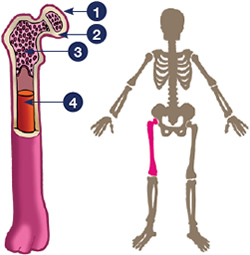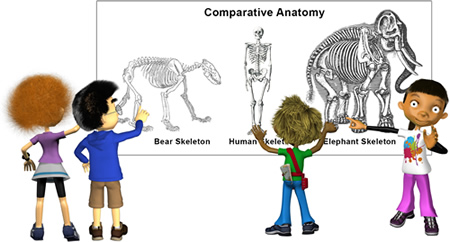Bones provide the structure for our bodies and protect and support our vital organs. In order to maintain strong and healthy bones, we have to take good care of them by supplying our body with the nutrients and exercise it needs.
A printable PDF of the information on this page is available in the right-hand column.
All about your skeleton

Bones are what make up our skeleton. Rather like the poles in a tent, or the wooden frame of a house, our skeleton provides structure and support for our body. Our bones help us to stand, sit up, and walk, and also protect our organs. For example, our skull works like a helmet to protect our brain, and our ribs protect our lungs and heart.
Did you know that although bones are hard, they are made of living tissue? This means that they grow and change throughout our lives.
When a baby is born it has about 300 bones. However, by the time we are adults, we only have 206 bones. This is because, as we grow, smaller bones fuse (join together) and cartilage (strong, flexible tissue attached to a bone) is replaced by hard bone.
Here is a list of the major parts of our skeleton:
- Skull – protects the brain and provides the structure for our face. Babies have spaces between the bones in their skull so that the head can be compressed as they are born.
- Spine – protects the spinal cord, supports our body and gives us our posture. The spine consists of 26 vertebrae. The cartilage between the vertebrae works as a shock absorber.
- Ribs – protect the lungs, liver and heart. We have 12 pairs of ribs. Most of the ribs are attached to the breastbone (sternum), apart from the bottom two pairs, that are called ‘floating ribs’. These are joined to the spine.
Arms – our arms are joined to our shoulder blades (scapulae) and to the collar bone (clavicle). Each arm is made up of three bones: the humerus, the radius and the ulna. The humerus is sometimes called ‘the funny bone’ – it’s the one that hurts when you bang your elbow!
- Pelvis – supports our stomach and protects the bladder, intestines and the reproductive organs in females.
- Legs – our legs are joined to our pelvis. Our legs are large and strong so they can support our body. The thigh bone (femur) is the largest bone in the body. Our kneecap is called the patella and below the knee are the tibia (the shin bone) and the fibula (beside the tibia).
- Joints – where two bones meet. There are three kinds of joints: hinge joints, pivot joints and ball and socket joints. Our elbows and knees are hinge joints; they move in only one direction like doors. At the top of our neck we have a pivot joint that allows our head to move from side to side. Our shoulder is a ball and socket joint and can move all around.
Whenever we move, muscles pull on our joints. Muscles are joined to our bones by tendons.
Inside our bones

Bones are made up of four layers:
- Periosteum – the outer layer containing blood vessels and nerves that feed and give feeling to the bone.
- Cortical, compact or dense tissue – a hard, protective layer of bone which provides strength.
- Spongy or cancellous tissue – this tissue looks very much like honeycomb. It provides strength while being lightweight.
- Bone marrow – often described as a jelly-like substance, it fills cavities within bones. This is where our blood cells are made. We have three different types of blood cells: red blood cells, white blood cells and platelets.
Bone health
Our bones are fed nutrients such as calcium by our blood. Calcium is stored within bones and is essential to bone health. If we do not consume enough calcium in our diets, our body draws on the calcium already stored in the bones. Bones consistently remodel themselves by building up new bone tissue and breaking down old bone tissue.
It is extremely important to give your body all the nutrients it needs to build strong and healthy bones, especially during childhood and adolescence (periods of accelerated growth), or you may put yourself at risk of developing osteoporosis later in life.
About your peak bone density
As a child or adolescent, it is extremely important to exercise and ensure that your body is receiving the correct nutrients to help you grow. This will help to build a high peak bone density (sometimes called peak bone mass). This is when your bones are at their strongest.
Peak bone density is reached in your mid-twenties, when your bones are the strongest they ever will be. As you get older, your bones gradually deteriorate. Therefore, it is important to have a high peak bone density to minimise the ongoing effects of bone loss.
Reaching a high peak bone density is vital to prevent conditions such as osteoporosis. Osteoporosis occurs when your bones lose their strength and become brittle. This means that bones (especially hips and wrists) can break or fracture very easily, even from just a minor bump. Nearly two million Australians suffer from osteoporosis.
Building strong bones

Your body needs three important things to help it build strong bones and reduce your risk of osteoporosis later in life:
- Calcium – This is essential to bones and vital in building bone mass, growth and maintaining strong bones. Dairy is a major source of calcium. Three serves of dairy a day are recommended as part of a healthy diet and to keep your bones strong and healthy.
- Vitamin D – Vitamin D helps us to absorb calcium from food and drink. We get vitamin D from the sun, fish, and milk. The sun is a great source of Vitamin D, but we all know about the dangers of sunburn and skin cancer, so we must be careful how and when we expose ourselves to the sun (never spend long periods of time in the strong midday sun). Apart from vitamin D and calcium, other important nutrients you might hear of in regard to bone health are: protein, phosphorus, potassium, magnesium and zinc.
- Exercise – All exercise, but particularly weight-bearing and resistance exercise, is extremely important for maintaining strong and healthy bones. Weight-bearing exercises are exercises that are performed while you are on your feet, such as skipping, jogging, dancing or aerobics. Resistance exercises include lifting weights with your arms or legs. These exercises are great for bone strength and increasing bone mass because of the impact or strain they place on bones. Regular exercise also helps to strengthen muscles, which in turn helps to support joints.
Best bones for life fast facts
- More than half our bones are located in our hands and feet.
- We have 27 bones in each hand.
- The foot contains 26 bones and 33 joints.
- The smallest bone in the body is found inside the ear. It is only 3mm long and is called the stapes or stirrup bone.
- Giraffes have the same number of bones in their neck as humans (seven), but a giraffe’s bones are much, much larger.
- If we all lived long enough, everyone would develop osteoporosis.
- The human thigh bone (the femur) is stronger than concrete. It is the longest and strongest bone in our body. The femur is one quarter of the height of the body.
- The hyoid bone (found at the base of the tongue) is the only bone in our body that is not connected to any other bones.
- Would you believe that the basic structure of your skeleton and that of any other mammal is the same? This means you have a very similar skeletal structure to a dog, cat, whale, bat or elephant. Even though our shapes are very different, we all have a head at one end of our vertebrae and a tail bone at the other end, ribs that protect our organs, and four limbs.

References
The following links will direct you to the homepage of the websites used as references for this topic.
- Dairy Australia: www.dairy.edu.au
- Healthy Bones Australia: healthybonesaustralia.org.au
- The Children’s University of Manchester: www.childrensuniversity.manchester.ac.uk




